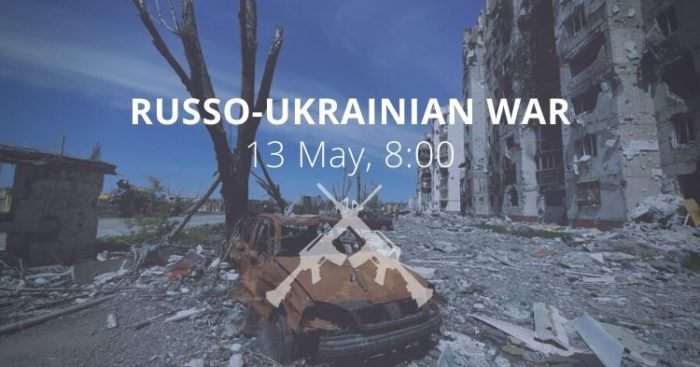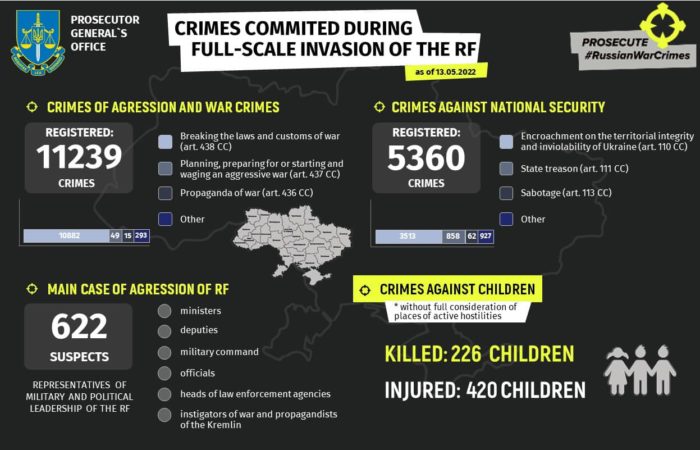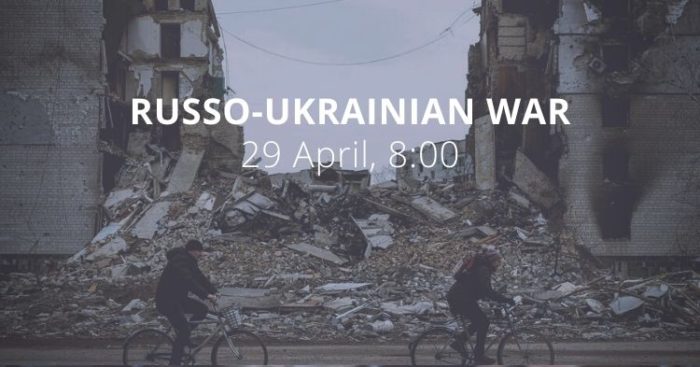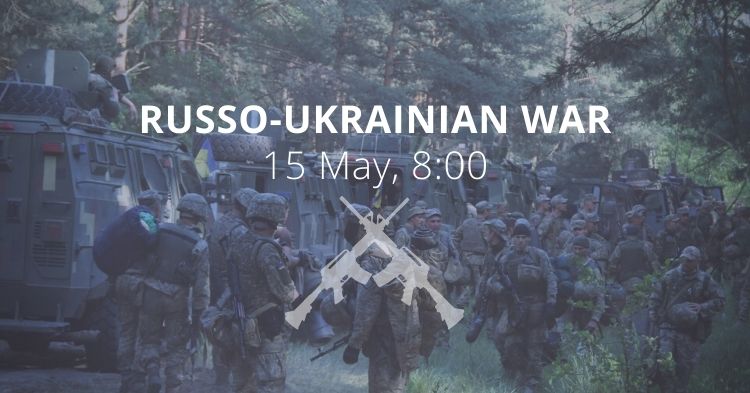Morning report day 79 – May 13
Situation
According to information from the General Staff:
Russian forces do not cease offensive operations in the Eastern Operational Zone to establish full control over the territory of Donetsk, Luhansk and Kherson oblasts and maintain the land corridor between these territories and the temporarily occupied Crimea. At the same time, it maintains tensions in the Transnistrian region of the Republic of Moldova and the territory of the Republic of Belarus.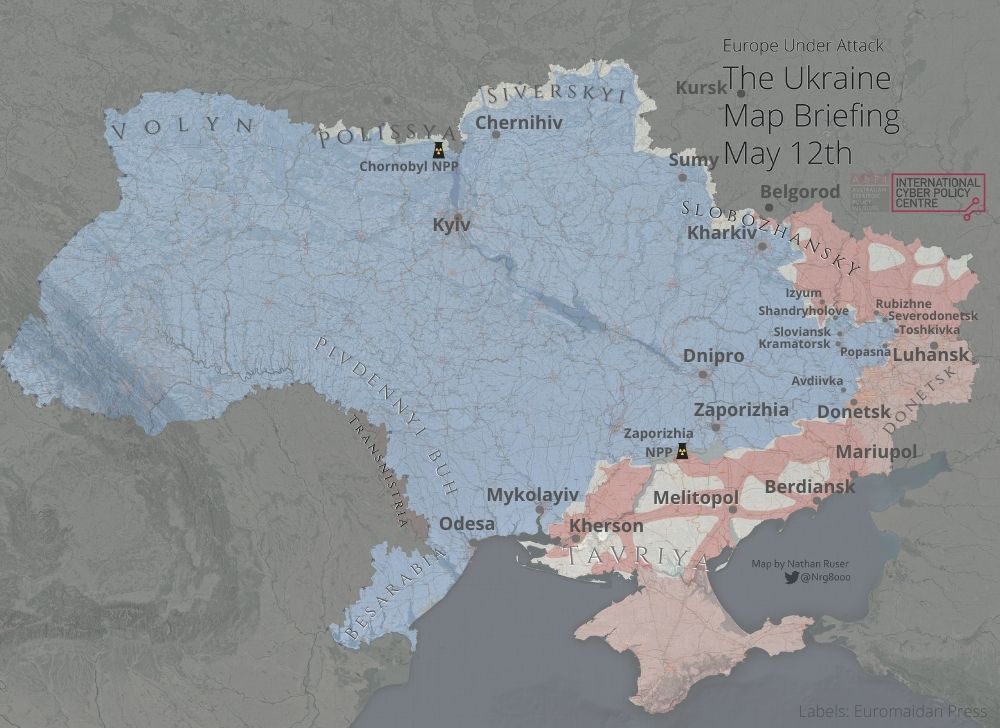
Russian forces did not take active action in the Volyn and Polissya areas. The main efforts of the armed forces of the Republic of Belarus were focused on covering the state border in Brest and Gomel oblasts.
- According to available information, the second stage of the readiness check of the units of the Armed Forces of the Republic of Belarus under the leadership of the Chief of the General Staff continues. A scheduled inspection of the readiness of the alarm system was carried out.
- The threat of missile and bomb strikes from the Republic of Belarus on infrastructure facilities on the territory of Ukraine continues.
In the Siversky direction, measures are being taken to strengthen the protection of the Ukrainian-Russian border in the Bryansk and Kursk oblasts. According to available information, Russian forces are transferring additional artillery units to the border areas of the Bryansk Oblast to increase provocative shelling of settlements in the Chernihiv Oblast, located near the state border of Ukraine.
- It carried out shelling of the border areas of Ukraine. Russian forces will likely continue to conduct demonstrations on this section of the state border of Ukraine and shelling from the territory of the Russian Federation to prevent the movement of units of our troops in other directions.
In the Slobozhansky direction, Russian forces took measures to regroup units, and replenish supplies of ammunition and fuel and lubricants to restore offensive capabilities.
- Russian forces did not conduct offensive operations in the Kharkiv direction. The main efforts were focused on preventing the advance of our troops in the area of the settlement of Vesele. During the day, the enemy fired on the positions of our troops in the areas of the settlements of Pitomnyk and Ruski Tyshky.
- In the Voronezh and Belgorod oblasts of the Russian Federation, the increased level of the terrorist threat has been extended until May 25, 2022.
- Russian forces did not take active action in the Sloviansk direction. Its main efforts were focused on replenishing supplies of material and technical means to increase offensive capabilities. It carried out shelling in the areas of settlements along the line of contact. Carried out air reconnaissance with the help of UAVs "Orlan-10".
In the Donetsk direction, Russian forces continue to focus their efforts on establishing full control over the settlement of Rubizhne. The occupiers used mortars, artillery, rocket-propelled grenade launchers, and launched rocket-bomb airstrikes to destroy the fortifications of Ukrainian units.
- In the Lyman direction, Russian forces units tried to gain a foothold in the area of the settlement of Oleksandrivka. Russian forces are trying to capture the area on the right bank of the Siversky Donets River. It carried out assault operations in the direction of the settlement of Novoselivka but was unsuccessful.
- In the Sievierodonetsk direction, the enemy continues to storm in the area of the settlement of Voyevodivka, without success.
- In the Bakhmut direction, Russian occupiers carried out assault operations in the direction of the settlement of Orikhove and the area of the settlement of Komyshuvakha but were unsuccessful.
- In the Avdiivka areas, Russian forces are storming to improve the tactical position of its troops but have no success.
- In the Kurakhiv direction, Russian forces conducted offensive operations in the direction of the settlement of Marinka.
- It continued to launch artillery and airstrikes on Mariupol, focusing its efforts on blocking units of our troops near the Azovstal plant. In order to establish full control over the city and suppress the resistance of Ukrainian defenders, it uses strategic aviation. Due to the evacuation of local residents, the fire should be expected to increase shortly.
- In the Novopavlovsk and Zaporizhzhia directions, Russian forces conducted artillery shelling of units of our troops along the entire line and air reconnaissance with the use of UAVs.
- Russian occupiers conducted air reconnaissance using UAVs in the Pokrovsk, Sloviansk and Pavlograd districts.
- In the Donetsk and Luhansk directions alone, the defenders of Ukraine repulsed eighteen enemy attacks and destroyed thirteen tanks, eight artillery systems, twenty-seven units of armored combat vehicles, two units of special engineering equipment and five enemy vehicles.
In the Pivdenny Buh directions, the occupying units did not carry out active hostilities, firing at units of our troops with artillery and mortars in the areas of the settlements of Oleksandrivka, Tavriyske, Kotlyareve, Hannivka and Osokorivka.
- His main efforts were focused on the fire damage to units of our troops and the expansion of the electronic warfare system.
- According to available information, the enemy has built up the air defense system in the western part of the Crimean Peninsula.
On the previous day, the air defense units of the Land Forces, the Air Force and the Air Assault Forces had hit seven air targets: five Orlan-10 UAVs, one Ka-52 helicopter and one cruise missile.
The Ukrainian air force in certain directions continued to fire at the enemy and support the fighting of our troops.
Russian occupiers continue to suffer losses in almost all directions.”
Ukraine thwarts the Russian battalion's river-crossing and destroys at least 58 vehicles inflicting heavy casualties as Donbas offensive stalls and Kyiv's troops' counter-attack, The Daily Mail reported. Russia was attempting to cross the Donets river at Bilohorivka to surround the city of Lysychansk, in the Donbas. But Ukrainian engineer claims to have successfully guessed where they would try to cross and laid a trap. The sound of tugboats putting the temporary bridge in place triggered a massive artillery and airstrike barrage. Satellite images show the bridge was destroyed along with dozens of Russian vehicles, inflicting heavy casualties.
A Russian ship has allegedly caught fire in the Black Sea due to the actions of the Ukrainian Armed Forces, a spokesman for the Odesa military administration, Serhiy Bratchuk, said, the NV claims. According to him, it is a vessel of logistics Vsevolod Bobrov. Earlier, Channel 24, citing intelligence sources, reported that a fire broke out on a Russian logistics vessel (and presumably Vsevolod Bobrov or Elbrus) heading for Zmiinyi (Snake) Island.
https://twitter.com/EuromaidanPress/status/1525051686527586304?s=20&t=r3LZNU21nQsGWpw2r6a5rA
Russian military continuing to use a Ukrainian airbase in occupied Melitopol, satellite images show, the CNN reports.
“The Russian military is continuing to use a Ukrainian airbase outside the occupied city of Melitopol, satellite images from BlackSky show. At least seven helicopters are seen at the airbase in a satellite image taken on May 12 at 3:58 p.m. local time. The use of the airbase by the Russians is important, given its strategic location between the occupied cities of Kherson, Mariupol, and parts of the Russian-backed separatist-held Donbas region. Although the airbase is deep within Russian-occupied territory, it doesn't mean the aircraft there are safe. In late March, Ukrainian forces successfully targeted the airport outside of Kherson, blowing up a number of Russian military helicopters”.
Putin is purging the leadership of the Russian Armed Forces
, The Daily Mail reports.
“Oleksiy Arestovych, a veteran of military intelligence and top adviser to Zelenskyy, has claimed that General Valery Gerasimov - chief of staff of the Russian armed forces - has been suspended. The commander of the first tank army of the western military district Lieutenant General Sergei Kisel has also been arrested and fired after the first tank army was defeated near Kharkiv. Two more Russian army generals and two naval commanders have either been sacked, arrested or investigated over battlefield losses, according to information from Ukraine's interior ministry. If confirmed, it would mark the largest purge of military upper ranks since Putin invaded Ukraine in February. Arestovych stressed that his information is 'preliminary', but it comes after Gerasimov failed to appear during Russia's Victory Day parade in Moscow on Monday which he was widely expected to attend.”.
According to British Defense Intelligence, (last 24 hours):
- Russia is investing significant effort in the vicinity of Izium and Sievierodonetsk in an attempt to achieve a breakthrough towards Sloviansk and Kramatorsk. The primary objective on this axis is to envelop Ukrainian forces in the Joint Forces Operation area, isolating them from support or reinforcement by units in the west of the country.
- Ukrainian forces successfully prevented an attempted Russian river crossing in the Donbas. Images indicate that during the crossing of the Siverskyi Donets river west of Sievierodonetsk, Russia lost significant armored maneuver elements of at least one Battalion Tactical Group as well as the deployed pontoon bridging equipment.https://twitter.com/EuromaidanPress/status/1524956062092247045?s=20&t=r3LZNU21nQsGWpw2r6a5rA
- Conducting river crossings in a contested environment is a highly risky maneuver and speaks to the pressure the Russian commanders are under to make progress in their operations in eastern Ukraine. Russian forces have failed to make any significant advances despite concentrating forces in this area after withdrawing and redeploying units from the Kyiv and Chernihiv Oblasts.
As of Friday 13 May, the approximate losses of weapons and military equipment of the Russian Armed Forces from the beginning of the war to the present day: 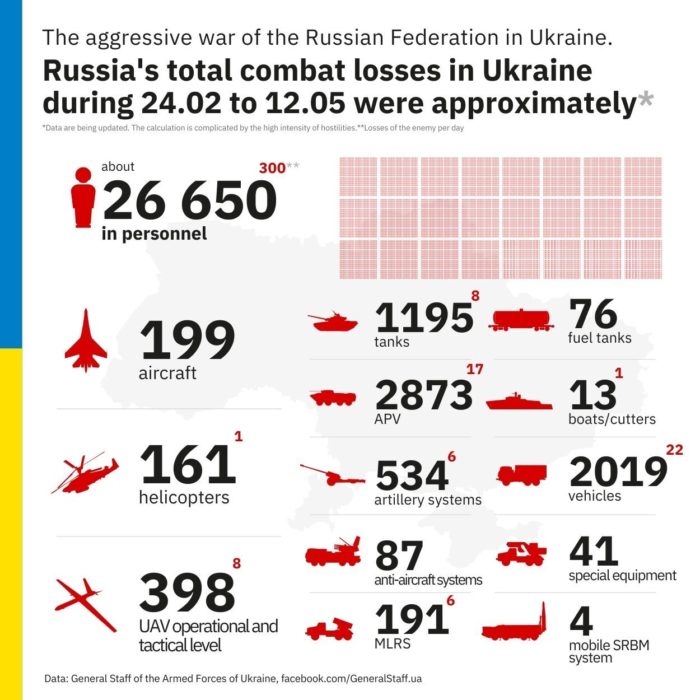
- Personnel – more than 26900 people (+250),
- Tanks – 1205 units (+10),
- Armored combat vehicles – 2900 units (+27),
- Artillery systems – 542 (+8),
- Multiple rocket launchers – 193 (+2)
- Air defense means – 88 (+1)
- Aircraft - 200 (+1),
- Helicopters - 162 (+1),
- Automotive technology and fuel tanks – 2042 (+23),
- Vessels/boats - 13 (+0),
- UAV operational and tactical level – 405 (+7),
- Special equipment – 41 (+0)
- Mobile SRBM system – 4 (+0)
- Cruise missiles –95 (+1),
Russian enemy suffered the greatest losses (of the last day) in the Kurakhiv direction.
Russia “patches up” broken units in Ukraine with rusty equipment from the 1960s, the Ukrainska Pravda reports citing the Defense Intelligence of Ukraine (DIU). The DIU has reported that Russia cannot fully restore the combat capability of military units withdrawn from Ukraine.
"The consequence of economic sanctions imposed by the world's leading powers on the aggressor country is the significant decline of Russia's defense industry.
Having lost a significant part of their technical military potential during the war in Ukraine, the Russians are already being forced to supply units that have suffered irreparable losses with equipment that was produced in the 1950 or 1960s. According to DIU, Russia is taking out equipment that has been rusting for decades in long-term storage warehouses. The military is being forced to accept these "rusty and rotten" vehicles and report to command about the "full manning and provision of combat units."
Humanitarian
Evacuation from Azovstal will start with taking severely injured people, according to the Deputy Prime Minister and Minister of Reintegration of Temporarily Occupied Territories of Ukraine as of May 12.
“Today representatives of the ICRC are meeting with RF reps to agree on this stage of special operation of evacuation from Azovstal. As such, the special operation has several steps. The first of those is - the evacuation of the severely injured.
We started a new round of negotiations regarding the road map of the special operation. We met ICRC and the UN, giving them a mandate. We want to sign a document on how exactly evacuation from Azovstal will take place. And we are preparing to sign it. As of now, not only Azov regiment troops are at the plant, but also Armed Forces, National Police, and State Border Guards. And they all need to be saved. Türkiye agreed to be an intermediate in the current round of negotiations.”
Russian army destroyed almost 38,000 houses in Ukraine, the Ukrinform reports. More than 220,000 Ukrainian citizens need housing as the Russian army has already destroyed almost 38,000 residential buildings in Ukraine, Verkhovna Rada Human Rights Commissioner, Liudmyla Denisova, wrote on Telegram.
“She said she had signed a Memorandum of Cooperation with the International Association ATA, aimed at providing temporary housing to citizens who lost their homes as a result of Russia's armed aggression.”
According to UNHCR 6,029,705 refugees have been registered as of May 11. The UN says that so far Poland has taken in 3,272,943 refugees, Romania 895,828, Russian Federation 785,348, Hungary 583,066, Republic of Moldova 459,546, Slovakia 409,527 and Belarus 27,308. Among those who fled Ukraine are also Ukrainian nationals with dual citizenship. An additional 105,000 people moved to the Russian Federation from the Donetsk and Luhansk oblasts between 18 and 23 February.
The number of Ukrainians entering Ukraine since February 28 is 1,626,500 as of May 11. This figure reflects cross-border movements, which can be pendular, and does not necessarily indicate sustainable returns.
OHCHR recorded 7,326 civilian casualties in Ukraine as of May 11. 3,541 were killed (including 239 children) and 3,785 injured (including 355 children).
Economic impact
War forces Ukraine to divert $8.3 bln to military spending, tax revenue drops – minister, the Reuters reports.
The figure, which has not been disclosed by Ukraine's government before, lays bare the economic maelstrom that Ukraine is navigating as its soldiers try to keep Russia's renewed offensive at bay in the country's east.
The spending -- drawn from some funds initially budgeted for development -- went on everything from buying and repairing weapons to emergency support for internally displaced people, Finance Minister Serhiy Marchenko said. There are 2.7 million officially registered IDPs, according to data from the social policy ministry, although the real figure is many times higher.
The government only collected 60% of its planned tax revenue for April, a shortfall that was topped up to the equivalent of 79.5% by grants from foreign partners, Marchenko told Reuters in exclusively written comments. Marchenko said that Kyiv urgently needed foreign support to be ramped up as it is being forced to funnel billions of additional dollars into emergency spending.
Marchenko said that Ukraine had received almost $2 billion in external funding in April, of which $719 million had come from grants. The figure for the period since February stands at$5.4 billion, including $801 million in grants, he said.
"If we do not take into account foreign aid, we now estimate the receipt of revenues in May-June at the level of 45-50% of (what was) planned, provided that the situation does not worsen," Marchenko said.”
Mine clearance in Ukraine may take up to 10 years, the Ukrainska Pravda reports. About 300,000 square kilometers of Ukraine's territory needs humanitarian mine clearance due to the large number of munitions left behind by Russian forces.
“The Russians are using remote mining systems, laying unguided minefields in settlements and leaving behind a large number of particularly dangerous deliberately installed explosive devices. These are lethal to civilians. Oleh Bondar, Head of the Pyrotechnic Operations and Humanitarian Demining Department of the State Emergency Service of Ukraine, quoted by Ukrinform. These mines and ammunition have been found in Kyiv, Chernihiv, Kharkiv, Sumy, Mykolaiv, Zaporizhzhia, Dnipropetrovsk, Donetsk and Luhansk Oblasts.
The total number of various mines, cluster munitions and deliberately installed explosive devices is about 10% of all explosives detected and disposed of.”
Ukraine will not reopen the gas route until it controls the pipeline system, the Reuters reports.
“Ukraine will not reopen the Sokhranovka gas transit route from Russia to Europe until Kyiv obtains full control over its pipeline system, the head of operator GTSOU told Reuters on Thursday. The company on Tuesday declared force majeure citing gas theft by Russia-backed separatists and halted flows via Sokhranovka, which accounts for almost a third of the gas Russia sends across Ukraine to Europe.
The pipeline runs through Ukraine's Luhansk region, part of which has been under the control of Russia-backed separatists since 2014. "We won't open. Until full control over the asset," GTSOU boss Sergiy Makogon said in written comments. Makogon said Gazprom could still deliver all its Europe-bound volumes by using the Sudzha transit route, which remains open.”
Legal
Invaders open fire on civilian evacuation convoy in Kherson Oblast, the Ukrinform reports. In the evening, Russian invaders fired artillery at a convoy of civilians fleeing the occupied territory of the Kherson Oblast. This was announced by the head of Kryvyi Rih’s military administration, Oleksandr Vilkul, on Telegram, Ukrinform reports.
In a first, a Russian soldier will stand trial in Ukraine on war crimes charges, The New York Times reports.
“A 21-year-old Russian soldier accused of shooting a civilian on a bicycle and leaving him dead on the side of the road will be the first Russian service member to stand trial in Ukraine for war crimes since the invasion, Ukraine’s prosecutor general said on Wednesday. The soldier is in Ukrainian custody and was identified by the prosecutor general, Iryna Venediktova, as Sgt. Vadim Shysimarin. Sergeant Shysimarin faces 10 to 15 years in prison. It was not immediately clear how he came to be in custody or when the landmark trial may begin.”
https://twitter.com/EuromaidanPress/status/1525068035186380801?s=20&t=r3LZNU21nQsGWpw2r6a5rA
UN considers investigation into possible Russian war crimes in Ukraine
, the Reuters reports.
“The UN Human Rights Council will decide on Thursday whether to launch an investigation into possible war crimes by Russian troops in the Kyiv area, a move that Russia said would amount to political score-settling. Members were due to vote on a resolution brought by Ukraine and supported by 59 other countries, to order a Commission of Inquiry to investigate events in the oblasts around Kyiv that were temporarily held by Russian troops.
"The areas ... which have been under Russian occupation in late February and March have experienced the most gruesome human rights violations on the European continent in decades," Ukraine's First Deputy Minister of Foreign Affairs, Emine Dzhaparova, told the Council.”
Ukrainians in Crimea are forced to join the Russian army, deprived of the right to land, the Ukrinform reports.
"The situation in Crimea is overshadowed by a new wave of active Russian military aggression in Ukraine. Ukrainians in Crimea are drafted into the Russian army and are forced to fight against their homeland. Refusal is punished with detention and imprisonment. They are deprived of the right to own land plots in Crimea, to study in their native language. Religious institutions are closed or arrested by the occupation authorities," First Deputy Minister of Foreign Affairs of Ukraine Emine Dzheppar said at the 34th session of the UN Human Rights Council in Geneva”.
Russian ships carrying stolen Ukrainian grain turned away from Mediterranean ports, but not all of them, the CNN reports. “Kateryna Yaresko, a journalist with the SeaKrime project of the Ukrainian online publication Myrotvorets, told CNN the project had noticed a sharp increase in grain exports from Sevastopol -- to about 100,000 tons in both March and April.
Crimea, annexed by Russia in 2014, produces little wheat because of a lack of irrigation. But the Ukrainian oblasts to its north, occupied by Russian forces since early March, produce millions of tons of grain every year. Ukrainian officials say thousands of tons are now being trucked into Crimea. A Russian merchant ship loaded with grain stolen in Ukraine has been turned away from at least one Mediterranean port and is now in the Syrian port of Latakia, according to shipping sources and Ukrainian officials. CNN has identified the vessel as the bulk carrier Matros Pozynich.
Mikhail Voytenko, editor-in-chief of the Maritime Bulletin, told CNN that the grain could be reloaded onto another ship at Latakia to disguise its origins. "When the destination port starts to change without any serious reason, this is another proof of smuggling," he said.
The Ukrainian Defense Ministry estimates that at least 400,000 tons of grain have been stolen and taken out of Ukraine since Russia's invasion. Mykola Solsky, Ukraine's Minister of Agrarian Policy and Food, said this week it is "sent in an organized manner in the direction of Crimea. This is a big business that is supervised by people of the highest level.”
226 children were killed, and 420 children injured, the Office of the Prosecutor General of Ukraine reports as of May 13. 1,721 educational establishments are damaged as a result of shelling and bombings, 139 of them are destroyed fully. 11,239 crimes of aggression and war crimes and 5,360 crimes against national security were registered.
Support
America’s massive ‘lend-lease’ aid plan for Ukraine recalls similar help in Britain’s ‘darkest hour’, The Conversation points out while explaining the benefits of the US “Lend-Lease-agreement” and how it will help speed up the support of Ukraine’s war efforts.
Given the intensity of the fighting and the scale of the attacks on Ukrainian cities and villages by the Russian armed forces, the continued supply of increasingly heavy weapons to Ukraine faces several obstacles. The most immediate is logistics, most weapons are transferred to Ukraine through Poland either by rail or air transport and these supply lines are vulnerable to attack. Another issue is that some of the heavier weapon systems (artillery, armored vehicles, and air defense systems) require some training of Ukrainian forces before they can be used in battle. There are also legal and procedural issues. The president can only spend funds appropriated by Congress, and if weapons are sold or transferred to Ukraine they are subject to the Foreign Assistance Act (FSA) and the Arms Export Control Act (AECA). The FSA puts strict human rights conditions on the provision of both non-military and military aid. The AECA requires certification by countries receiving arms or military technology that the weapons are used either for internal security or self-defense and will not be used to escalate a conflict. These requirements create bureaucratic obstacles to each arms shipment and given the ambiguous phrasing of the law and the fluid nature of the conflict in Ukraine, potentially put US manufacturers at risk of prosecution. The solution by the Biden administration to introduce a new lend-lease agreement is a very imaginative way to get around some of these bureaucratic and procedural issues which could otherwise risk significant delays to the delivery of this aid. The Ukraine Democracy Defense Lend-Lease Act specifies that arms deliveries to Ukraine are exempt from various conditions laid down by the two acts relating to human rights conditions and the requirement to pay for weapons and other assistance provided. The basic principle of lend-lease is that arms supplies are not sold or donated, but rather provided on the basis that they will eventually be returned to the United States. But in this case, the US government is bypassing the usual regulations governing such transactions by accepting that there is no guarantee that any of the equipment will actually be returned or paid for after the end of the conflict. The administration expects that the new law will considerably reduce the delay in weapons actually reaching the Ukraine military.
EU to disburse second €600 mln tranche in macro-financial assistance to Ukraine by May 20, the Ukrinform reports.
"Yesterday, the European Commission adopted a decision necessary for the disbursement of the second tranche of the emergency macro-financial assistance program for Ukraine and the loan of these funds on the capital market. The second tranche totals 600 million euros. The practical transfer of this sum is expected by May 20," Dana Spinant, Deputy Chief Spokeswoman of the European Commission, said at a press briefing in Brussels”.
https://twitter.com/EuromaidanPress/status/1524976744796721155?s=20&t=r3LZNU21nQsGWpw2r6a5rA
EU not to recognize Russian ‘referendums’ within temporarily occupied areas of Ukraine, the Ukrinform reports.
“Russia’s attempts to hold the so-called ‘referendums’ within the temporarily occupied areas of Ukraine, intended to proclaim the establishment of the new ‘people’s republics’ or annex these territories, will be viewed as illegal and will not be recognized. The relevant statement was made by the EU mission at the OSCE Permanent Council meeting in Vienna on Thursday.
The EU mission condemned Russia’s attempts to create illegitimate alternative administrative structures in Kherson, Mariupol, and other Ukrainian cities. Any Russian attempts to hold the so-called ‘referendums’ at gunpoint within the territories controlled by Russian troops will be illegal and will not be recognized, the EU mission stressed. In addition, the EU mission condemned the forcible deportation of Ukrainians to the Russian Federation and the so-called “filtration camps”.”
New developments
- Putin’s associate warns that arms supply to Ukraine could escalate into a nuclear war, the Ukrainska Pravda reports. “In the context of the proxy war with Russia unleashed by Western countries I want to articulate very clearly once again the things that are already obvious to all reasonable people: 1. NATO countries’ pumping of weapons into Ukraine, the fact that it is training its troops to use Western equipment, sending mercenaries, and conducting exercises by Alliance countries near our borders increase the likelihood of a direct and open conflict between NATO and Russia. 2. Such a conflict always carries the risk of turning into a fully-fledged nuclear war”, said Dmitry Medvedev, deputy chairman of the Russian Security Council on Telegram.
- Ukraine reminds the EU of European indecisiveness before WW2, and calls for an immediate embargo on Russian oil, the Ukrinform reports. "If the leaders had acted decisively in 1938, Europe could have avoided WWII. But politicians acted cowardly & flirted with the aggressor. The result is a million tragedies. History won’t forgive us if we make the same mistake again. EU must impose an embargo on Russia's oil immediately," Podoliak wrote on Twitter.
- Russia says Finnish entry to NATO poses a threat to which it will respond, the Reuters reports. “Russia said on Thursday that Finland's bid to join NATO was a hostile move that "definitely" posed a threat to its security. The Kremlin said it would respond but declined to spell out how, saying this would depend on how close NATO moves military assets towards the 1,300 km (800-mile) Finnish-Russian frontier. The Russian Foreign Ministry said Russia would need to take "retaliatory steps, both of a military-technical and other nature, in order to stop threats to its national security arising".
- Swiss released some frozen Russian assets, the Reuters reports. “The Swiss government on Thursday reported 6.3 billion Swiss francs ($6.33 billion) worth of Russian assets frozen under sanctions to punish Moscow's invasion of Ukraine, a drop from early April as around 3.4 billion francs in provisionally blocked assets were released. We can't freeze funds if we do not have sufficient grounds, Bollinger, a senior official at the State Secretariat for Economic Affairs (SECO) agency overseeing sanctions, told journalists. The US Helsinki Commission, a government-funded independent commission which looks at security, cooperation and human rights issues in Europe, in early May, called Switzerland a leading enabler of Russian dictator Vladimir Putin and his cronies, who the commission said used Swiss secrecy laws to hide and protect the proceeds of their crimes".
- Russia is opposed to Ukraine's accession not only to NATO but also to the EU, the Ukrainska Pravda reports. “Dmitry Polyansky, Deputy Permanent Representative of the Russian Federation to the UN, said that Russia's position on the possible entry of Ukraine into the EU has changed and has become similar to the position on Ukraine's entry into NATO.”
Assessment
On the War
The Institute for the Study of War has made the following assessment as of Thursday 12 May:
Russian forces may be abandoning efforts at a wide encirclement of Ukrainian troops along the Izium-Sloviansk-Debaltseve line in favor of shallower encirclements of Sievierodonetsk and Lysychansk.
Russian forces likely control almost all of Rubizhne as of May 12 and have likely seized the town of Voevodivka, north of Severdonetsk. They will likely launch a ground offensive on or around Sievierodonetsk in the coming days. The relative success of Russian operations in this area combined with their failure to advance from Izium and the notable decline in the energy of that attempted advance suggest that they may be giving up on the Izium axis. Reports that Russian forces in Popasna are advancing north, toward Sievierodonetsk-Lysychansk, rather than east toward the Sloviansk-Debaltseve highway, support this hypothesis.
It is unclear if Russian forces can encircle, let alone capture, Sievierodonetsk and Lysychansk even if they focus their efforts on that much-reduced objective. Russian offensives have bogged down every time they hit a built-up area throughout this war, and these areas are unlikely to be different.
Continued and expanding reports of demoralization and refusals to fight among Russian units suggest that the effective combat power of Russian troops in the east continues to be low and may drop further. If the Russians abandon efforts to advance from Izium, moreover, Ukrainian forces would be able to concentrate their efforts on defending Sievierodonetsk-Lysychansk or, in the worst case, breaking a Russian encirclement before those settlements fall.
The Ukrainian counteroffensive around Kharkiv is also forcing the Russian command to make hard choices, as it was likely intended to do. The UK Ministry of Defense reports that Russian forces pulled back from Kharkiv have been sent toward Rubizhne and Sievierodonetsk but at the cost of ceding ground in Kharkiv from which the Russians had been shelling the city.
The counteroffensive is also forcing Russian units still near the city to focus their bombardment on the attacking Ukrainian troops rather than continuing their attacks on the city itself. The Ukrainian counteroffensive near Kharkiv is starting to look very similar to the counteroffensive that ultimately drove Russian troops away from Kyiv and out of western Ukraine entirely, although it is too soon to tell if the Russians will make a similar decision here.
Key Takeaways
- Russian forces made marginal gains to the north of Sievierodonetsk and have likely captured Rubizhne and Voevodivka.
- Russian forces fired intensively on Ukrainian positions in northern Kharkiv to stop the ongoing Ukrainian counteroffensive around Kharkiv City. The artillery focus on Ukrainian positions has likely diverted the Russian artillery that remains in range of Kharkiv to the more urgent task of stopping the Ukrainian advance.
- Russian forces are strengthening their position on Zmiinyi (Snake) Island in an effort to block Ukrainian maritime communications and capabilities in the northwestern Black Sea on the approaches to Odesa.“
Analysts say the outcome of fighting now is riding on the accuracy, quantity, and striking power of long-range weapons. Ukraine is pleading for more, The New York Times reports. Military analysts say the battle now is riding not so much on the skill or bravery of Ukrainian soldiers, but on the accuracy, quantity, and striking power of long-range weapons.
The Ukrainian Army does fire back from artillery operating to the rear of this position but has too few weapons to dislodge the Russian gun line. … Throughout the war, Ukraine’s army has demonstrated extraordinary success in outmaneuvering and defeating Russian forces in the north, relying on stealth and mobility to execute ambushes against a bigger, better equipped army. But in southern Ukraine, in an area of pancake-flat farm fields cut by irrigation canals, the Ukrainians are fighting a different sort of war. On the steppe, the swirling, fluid front lines of the two armies are spaced miles or dozens of miles apart, over an expanse of gigantic fields of yellow rapeseed, green winter wheat, tilled under black earth and tiny villages. Occasionally, small units slip into this buffer zone to skirmish, and to call in artillery strikes on one another, using sparse tree lines as cover. “There is no place to hide,” the commander of a reconnaissance brigade who is deploying units into these fights, said in an interview. He asked to be identified only by his nickname, Botsman. … Ukraine entered the war at a disadvantage. Russia’s 203-millimeter Peony howitzers, for example, fire out to about 24 miles while Ukraine’s 152-millimeter Geocent guns fire 18 miles. (Soviet legacy artillery systems, used by both sides, are named for flowers; Carnation and Tulip guns are also in play in the war.) That’s why Ukrainians so desperately want the American howitzers; their 25-mile range while firing a GPS-guided precision round would, in some places, tilt the advantage slightly back to them. “The Russians have two advantages now, artillery and aviation,” said Mykhailo Zhirokhov, the author of a book about artillery combat in the war against Russian-backed separatists in eastern Ukraine, “Gods of Hybrid War.” “Ukraine needs artillery and antiaircraft missiles. These are critically important on the front.” The Ukrainian military has an insufficient quantity of even medium-range artillery, such as weapons that might hit back at the Russian gun line harassing the Ukrainian unit about nine miles away.… Russia cannot capitalize on its artillery superiority to advance. Its tactic for attacking on the open plains is to hammer the opposing positions with artillery, then send armored vehicles forward on a maneuver called “reconnaissance to contact” aimed at overwhelming what remains of the defensive line. But because of Ukraine’s wealth of anti-armor missiles and weapons, Russia cannot advance and seize ground. Ukraine, meanwhile, also cannot advance, though its tactics differ. The Ukrainian military relies on small unit infantry with armored vehicles playing only supporting roles. Though Ukraine could seize ground, it could not hold it or use it for logistical support for further advances, as any new territory would remain under Russian bombardment. The planned Ukrainian advance in this area depends on the arrival of the M777 howitzers and other long-range Western artillery that can hit the Russian artillery in the rear. Then, Ukrainian infantry might advance under the artillery umbrella of these longer-range systems. Should more powerful artillery arrive, it could quickly tip the scales, said Oleksiy Arestovych, an adviser to Mr. Zelenskyy’s chief of staff. In the fighting on the west bank of the Dnipro River, Russia’s objective appears to be tying down Ukrainian forces that might otherwise shift to the battle for the Donbas Oblast in eastern Ukraine. Ukraine’s goal, once it obtains artillery able to match the range of Russian guns, is to move over the fields to within striking range of two bridges and a dam crossing the Dnipro River in an operation that could cut supply lines of the Russian forces, Mr. Arestovich, the presidential adviser, said. “We would do it with pleasure,” said Col. Taras Styk, a commander in the 17th Tank Brigade. “But now we have nothing that can hit them.”
Ukraine will fight for Zmiinyi (Snake) Island as much as necessary, the head of the Ukrainian Defense Intelligence of Ukraine (DIU) said. “
The island is of strategic importance for both Ukraine and the Russian occupiers, as it allows controlling the surface and to some extent the air situation in southern Ukraine. Zmiinyi (Snake) Island is also strategically important in terms of Russia's ability to land a tactical naval landing.
According to Major General Kirill Budanov, this is theoretically the only region through which the Russian occupiers can try to land on the territory of the occupied Transnistrian region of Moldova. “The one who controls the island can at any time block the movement of civilian vessels in all directions to the south of Ukraine… Zmiinyi (Snake) Island is the territory of Ukraine, and we will de-occupy it and fight for it as much as we need. This is a strategically important point to open trade routes, import weapons, and exclude any possible Russian military action on the territory of the Transnistrian Oblast, from which they can attack the western part of Ukraine," he said.
[Hans Petter Midttun: It is not the island, but the capabilities of the Russian Armed Forces station on it that threaten Ukraine and influence the situation in the Black Sea. It offers the very same capability that the Black Sea Fleet is exercising daily. The only difference is that it offers permanent stationing. More crucially, it helps legitimize Russian legal claim over its territorial waters and adjacent maritime exclusive zones.]

